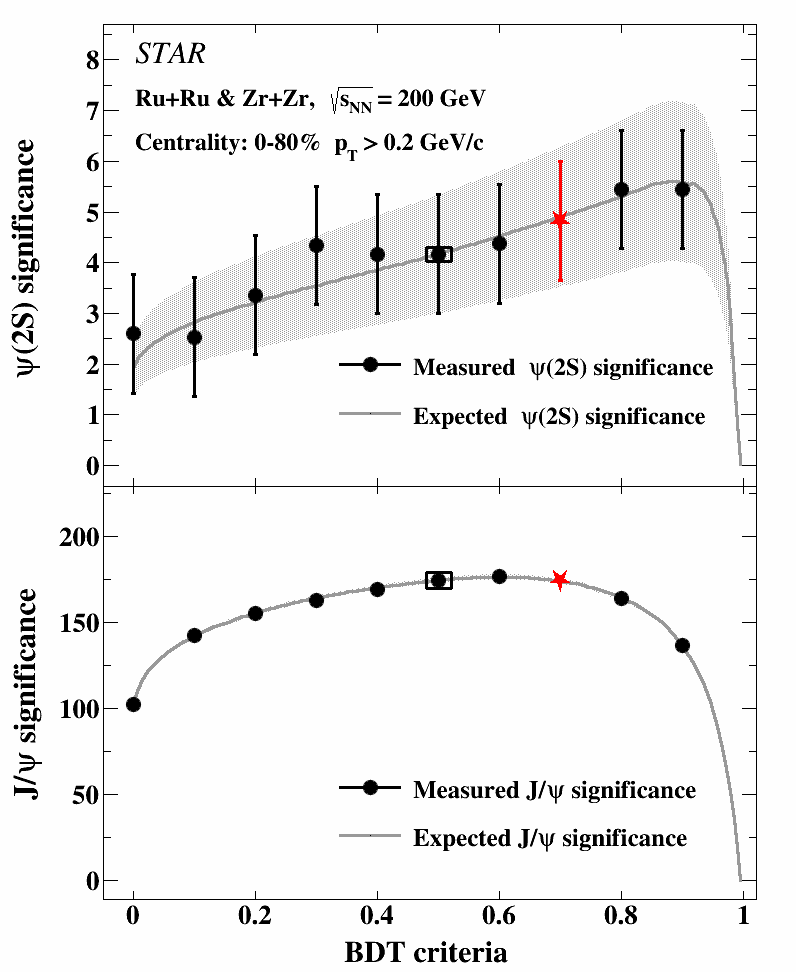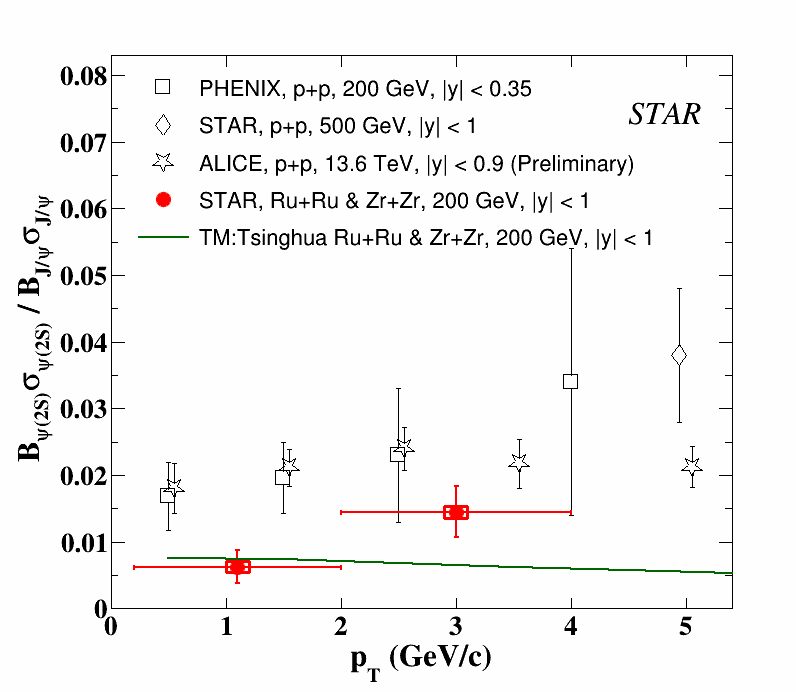Observation of charmonium sequential suppression in heavy-ion collisions at Relativistic Heavy Ion Collider
Observation of charmonium sequential suppression in heavy-ion collisions at Relativistic Heavy Ion Collider
PAs: Rongrong Ma, Kaifeng Shen, Zebo Tang,Yan Wang, Qian Yang, Wangmei Zha
Target Journal: Phys. Rev. Lett.
Abstract:
We report measurements of charmonium sequential suppression in high-energy Ru+Ru and Zr+Zr collisions with the STAR experiment at the Relativistic Heavy Ion Collider (RHIC). The inclusive yield ratio of ψ(2S) to J/ψ as a function of transverse momentum is reported, along with the centrality dependence of the double ratio, defined as the ψ(2S) to J/ψ ratio in heavy-ion collisions to that in p+p collisions. In the 0-80% centrality class, such a double ratio is 0.41 ± 0.10 (stat) ± 0.03 (syst) ± 0.02 (norm), lower than unity with a significance of 5.6 standard deviations. This provides experimental evidence that ψ(2S) is significantly more suppressed than J/ψ in heavy-ion collisions at RHIC. It is also observed that such a sequential suppression pattern is more pronounced at lower transverse momentum.
Figures:
|
|
| Figure 1. Signal significance of ψ(2S) and J/ψ as a function of BDT threshold in 0-80% Ru+Ru and Zr+Zr collisions. The solid markers represent significances extracted from data, while solid curves represent the expected significances from the machine learning. Error bars around data points and bands around solid curves indicate statistical uncertainties. The measured and expected distributions are aligned at the threshold value of 0.5, as indicated by the open boxes. The signal significance corresponding to the default BDT threshold is indicated by stars. |
|
|
| Figure 2. Invariant mass distributions of ψ(2S) and J/ψ candidates for pT > 0.2 GeV/c reconstructed via the dielectron channel within |y| < 1 for 0-80% Ru+Ru and Zr+Zr collisions. The combinatorial background estimated using the mix-event technique is shown as triangles. Background-subtracted distributions (full circles) are fitted. Fit results are shown by the solid curves, while curves of other styles represent individual components included in the fit. The mass ranges used for determining the signal counts are highlighted as shaded bands. |
|
|
| Figure 3. Double ratios of ψ(2S) to J/ψ as a function of ⟨Npart⟩ [NA50:2006yzz, Hushnud:2023kwf] are shown in the left panel. The result integrated over centrality (⟨Npart⟩ = 63) for Ru+Ru and Zr+Zr collisions is presented in the right panel. For measurements from heavy-ion collisions, the error bars indicate statistical uncertainties, while the boxes denote systematic uncertainties. Other results [PHENIX:2013pmn] only display total uncertainties, which are calculated by adding statistical and systematic uncertainties in quadrature. |
|
|
| Figure 4. Transverse momentum (pT) dependence of the ψ(2S) to J/ψ yield ratio in p+p [PHENIX:2011gyb, STAR:2019vkt, Arsene:2024fdb] and heavy-ion collisions. The vertical bars and boxes around data points represent statistical and systematic uncertainties, respectively, while the horizontal bars indicate the bin width. |
Summary:
In summary, we report on measurements of inclusive ψ(2S) and J/ψ production in Ru+Ru and Zr+Zr collisions at √sNN = 200 GeV with the STAR experiment at RHIC. The pₜ-integrated double ratio, i.e., ratio of ψ(2S) to J/ψ yield ratio between heavy-ion and p+p collisions, in the 0–80% centrality class is lower than unity with a significance of 5.6 standard deviations, providing strong evidence that the ψ(2S) is significantly more suppressed than J/ψ in heavy-ion collisions at RHIC compared to p+p collisions. The double ratio is also smaller than the interpolated value for p+Au collisions at √sNN = 200 GeV, indicating additional suppression of ψ(2S) relative to J/ψ in the QGP beyond the CNM effects. Hints of increasing relative suppression from peripheral to central collisions and with increasing pₜ are seen. The results presented in this letter advance our understanding of charmonium suppression mechanisms as well as the thermodynamic properties of the QGP, and offer additional constraints for model calculations.
Related presentations:
Here is a summary of links about related presentations on pwg meeting.
- https://drupal.star.bnl.gov/STAR/system/files/psi2s%20raw%20yield%20in%20isobar%20collisions_0.pdf
- https://drupal.star.bnl.gov/STAR/system/files/psi%282s%29_embedding_requst_v3.pdf
- https://drupal.star.bnl.gov/STAR/system/files/psi%282s%29_analysis_pwg_v2.pdf
- https://drupal.star.bnl.gov/STAR/system/files/psi%282s%29_analysis_preliminary_v2_0.pdf
- https://drupal.star.bnl.gov/STAR/system/files/psi2s_pp_pA_ref_v1_0.pdf
- https://drupal.star.bnl.gov/STAR/system/files/PWG_20240314_Yan.pdf
Paper draft:
- https://drupal.star.bnl.gov/STAR/blog/wy157543/psi2s-paper
Analysis note:
- https://drupal.star.bnl.gov/STAR/blog/wy157543/psi2snote
- wy157543's blog
- Login or register to post comments


.png)

